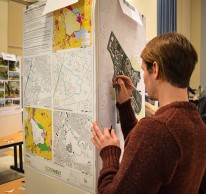The City of Austin is in the process of rewriting its land development code through an initiative called CodeNEXT and is calling upon Austenites to get involved. Residents are asked to help the CodeNEXT team to better understand the diverse character of the built environment found across the city’s various communities.

In late January, Dan Parolek and John Miki traveled to Austin, TX, to kick off community character documentation. This new documentation process dubbed “Community Character in a Box” builds upon past efforts used by city, but offers a new take on the public engagement process, in an effort to further open the channels of communication between the city government and the community.
Community character documentation is a two-step process that includes mapping the assets (strengths), constraints (weaknesses), and opportunities of each community, and documenting existing community character through photographs. At the community event, maps for the 103 neighborhood reporting areas were prepared and posters of photographs taken of 13 of Austin’s neighborhoods were presented.
Participants were asked to mark the maps with notes and colored dots showing assets (popular social spaces, civic institutions, parks, etc.); constraints (abandoned buildings, dangerous routes, hazards); and opportunity sites (empty lots, amenities that would benefit from improvement, places for public art). They were also given the opportunity to comment on the posters comprised of photographs of the character of the neighborhood.
In order to further document the other 90 neighborhood reporting areas found in Austin and to reach out to community members unable to participate in the workshops, the CodeNEXT team prepared “Community Character in a Box” roll-out kits containing instructions on how to map their community and document the existing built environment through photographs.
The do-it-yourself kits, which include a set of neighborhood maps and supplies, will be made available this week to more than 80 hosts who have already signed up to host or participate in documenting their community. Hosts are asked to organize a mapping session, in which Austenites will work in small groups to discuss their neighborhood’s assets, constraints, and opportunities, as well as document the built environment of their neighborhood through photography.
In late spring, the first set of communities documented will have all their photos and maps on view for the public through the city’s website. This process will continue through the end of 2014 with periodic updates to the website. The information collected will also be compiled into a Community Character Manual. The website and the Community Character Manual will serve as a resource for current and future planning efforts with in the city.
Watch a recent news broadcast about the project:
Like this article? How about these: